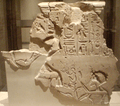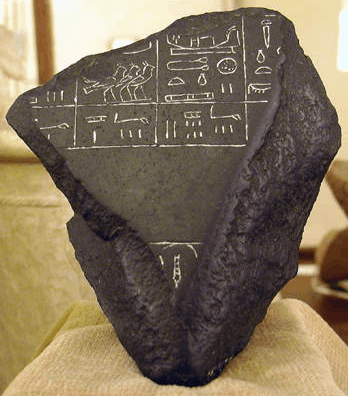Mast (hieroglyph)
The ancient Egyptian Mast hieroglyph is one of the oldest language hieroglyphs from Ancient Egypt. It is used on a famous label of Pharaoh Den of the First dynasty, but forms part of the location hieroglyph: Emblem of the East.
Nectanebo II's obelisk uses the Mast hieroglyph when describing the construction of his obelisk; in a S-Egyptian emphatic word construct he adds a vertical S, the folded cloth, Gardiner no. S29,
, at the beginning of the word "to erect". (see here, high res: , low res: )
| Mast hieroglyph #2 in hieroglyphs |
|---|
| Ship's Mast in hieroglyphs |
|---|
The Ship's Mast hieroglyph is used as a triliteral phonetic hieroglyphic to represent the sound sequence ꜥḥꜥ, which means "to stand erect", or "to stand vertical"; its use is extensive throughout the language history, and hieroglyphic tomb reliefs and story-telling of Ancient Egypt. It is possibly a forerunner hieroglyph kh3 , the sun rising upon the horizon.
In the 198 BC Rosetta Stone, the ship's mast hieroglyph has the unique usage in the final line of the Ptolemy V decree: the mast is used twice-(adjective, verb):
- engrave the decree..: "...upon a vertical-(mast) stone stele"..in the 3-language scripts, .."Shall be made to stand it in the sanctuaries in temples all..."
 Ship's Mast on label of Pharaoh Den, 1st Dynasty
Ship's Mast on label of Pharaoh Den, 1st Dynasty From right, hieroglyphs: sedge of the South, Papyrus clump with leaves of North-Nile Delta, wife-hieroglyph, the tree-hieroglyph, and the Ship's Mast hieroglyph
From right, hieroglyphs: sedge of the South, Papyrus clump with leaves of North-Nile Delta, wife-hieroglyph, the tree-hieroglyph, and the Ship's Mast hieroglyph Cartouche amulet, with variant form of mast hieroglyph
Cartouche amulet, with variant form of mast hieroglyph Old Kingdom of Ancient Egypt: Palermo stone fragment
Old Kingdom of Ancient Egypt: Palermo stone fragment Nectanebo II obelisk, stating that he 'erected' the obelisk, (using the Mast-hieroglyph)
Nectanebo II obelisk, stating that he 'erected' the obelisk, (using the Mast-hieroglyph)
See also
| Wikimedia Commons has media related to Mast (hieroglyph). |
- Gardiner's Sign List#P. Ships and Parts of Ships
- Gardiner's Sign List#U. Agriculture, Crafts, and Professions
- List of Egyptian hieroglyphs by common name: M-Z
- Mast
References
- Budge. An Egyptian Hieroglyphic Dictionary, E.A.Wallace Budge, (Dover Publications), c 1978, (c 1920), Dover edition, 1978. (In two volumes) (softcover, ISBN 0-486-23615-3)
- Budge. The Rosetta Stone, E.A.Wallace Budge, (Dover Publications), c 1929, Dover edition(unabridged), 1989. (softcover, ISBN 0-486-26163-8)
This article is issued from Wikipedia. The text is licensed under Creative Commons - Attribution - Sharealike. Additional terms may apply for the media files.